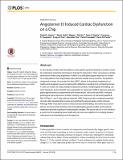| dc.contributor.author | Horton, Renita E. | en_US |
| dc.contributor.author | Yadid, Moran | en_US |
| dc.contributor.author | McCain, Megan L. | en_US |
| dc.contributor.author | Sheehy, Sean P. | en_US |
| dc.contributor.author | Pasqualini, Francesco S. | en_US |
| dc.contributor.author | Park, Sung-Jin | en_US |
| dc.contributor.author | Cho, Alexander | en_US |
| dc.contributor.author | Campbell, Patrick | en_US |
| dc.contributor.author | Parker, Kevin Kit | en_US |
| dc.date.accessioned | 2016-03-01T19:50:46Z | |
| dc.date.issued | 2016 | en_US |
| dc.identifier.citation | Horton, Renita E., Moran Yadid, Megan L. McCain, Sean P. Sheehy, Francesco S. Pasqualini, Sung-Jin Park, Alexander Cho, Patrick Campbell, and Kevin Kit Parker. 2016. “Angiotensin II Induced Cardiac Dysfunction on a Chip.” PLoS ONE 11 (1): e0146415. doi:10.1371/journal.pone.0146415. http://dx.doi.org/10.1371/journal.pone.0146415. | en |
| dc.identifier.issn | 1932-6203 | en |
| dc.identifier.uri | http://nrs.harvard.edu/urn-3:HUL.InstRepos:25658513 | |
| dc.description.abstract | In vitro disease models offer the ability to study specific systemic features in isolation to better understand underlying mechanisms that lead to dysfunction. Here, we present a cardiac dysfunction model using angiotensin II (ANG II) to elicit pathological responses in a heart-on-a-chip platform that recapitulates native laminar cardiac tissue structure. Our platform, composed of arrays of muscular thin films (MTF), allows for functional comparisons of healthy and diseased tissues by tracking film deflections resulting from contracting tissues. To test our model, we measured gene expression profiles, morphological remodeling, calcium transients, and contractile stress generation in response to ANG II exposure and compared against previous experimental and clinical results. We found that ANG II induced pathological gene expression profiles including over-expression of natriuretic peptide B, Rho GTPase 1, and T-type calcium channels. ANG II exposure also increased proarrhythmic early after depolarization events and significantly reduced peak systolic stresses. Although ANG II has been shown to induce structural remodeling, we control tissue architecture via microcontact printing, and show pathological genetic profiles and functional impairment precede significant morphological changes. We assert that our in vitro model is a useful tool for evaluating tissue health and can serve as a platform for studying disease mechanisms and identifying novel therapeutics. | en |
| dc.language.iso | en_US | en |
| dc.publisher | Public Library of Science | en |
| dc.relation.isversionof | doi:10.1371/journal.pone.0146415 | en |
| dc.relation.hasversion | http://www.ncbi.nlm.nih.gov/pmc/articles/PMC4725954/pdf/ | en |
| dash.license | LAA | en_US |
| dc.subject | Biology and Life Sciences | en |
| dc.subject | Genetics | en |
| dc.subject | Gene Expression | en |
| dc.subject | Medicine and Health Sciences | en |
| dc.subject | Cardiology | en |
| dc.subject | Heart Failure | en |
| dc.subject | Engineering and Technology | en |
| dc.subject | Architectural Engineering | en |
| dc.subject | Physical Sciences | en |
| dc.subject | Materials Science | en |
| dc.subject | Materials by Structure | en |
| dc.subject | Thin Films | en |
| dc.subject | Biophysics | en |
| dc.subject | Ion Channels | en |
| dc.subject | Calcium Channels | en |
| dc.subject | Physics | en |
| dc.subject | Physiology | en |
| dc.subject | Electrophysiology | en |
| dc.subject | Neurophysiology | en |
| dc.subject | Neuroscience | en |
| dc.subject | Biochemistry | en |
| dc.subject | Proteins | en |
| dc.subject | Biotechnology | en |
| dc.subject | Genetic Engineering | en |
| dc.subject | Arrhythmia | en |
| dc.subject | Membrane Potential | en |
| dc.subject | Depolarization | en |
| dc.title | Angiotensin II Induced Cardiac Dysfunction on a Chip | en |
| dc.type | Journal Article | en_US |
| dc.description.version | Version of Record | en |
| dc.relation.journal | PLoS ONE | en |
| dash.depositing.author | Horton, Renita E. | en_US |
| dc.date.available | 2016-03-01T19:50:46Z | |
| dc.identifier.doi | 10.1371/journal.pone.0146415 | * |
| dash.contributor.affiliated | Horton, Renita E. | |
| dash.contributor.affiliated | Sheehy, Sean Paul | |
| dash.contributor.affiliated | Campbell, Patrick | |
| dash.contributor.affiliated | Pasqualini, Francesco | |
| dash.contributor.affiliated | Parker, Kevin | |


